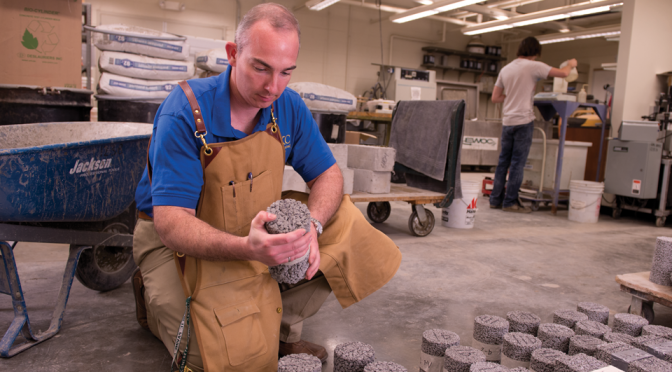When it comes to improving a centuries-old industrial process, it’s hard to imagine a more complete job than John T. Kevern, Ph.D., is crafting at UMKC’s School of Computing and Engineering.
Kevern’s approach to making concrete costs less than the current standard; reduces the product’s carbon footprint in two different ways; saves energy; and recycles waste that would otherwise end up in landfills — all with no impacts on the product’s strength or durability.
Considering that concrete is the most widely used man-made material on earth — irreplaceable in applications ranging from building construction to energy production, transportation, power generation and water/sewer systems — that’s a significant advance.
And yes, you can find individual buildings, roads, bridges, pipelines and power plants made without concrete. But humans have yet to produce a material with sufficient strength that can be produced in such volume at such a low cost. That’s why it is the most ubiquitous man-made product on the planet.
It’s also been around for, oh, 8,000 years or so. So why is the process being re-engineered in the 21st century in Kansas City?
Because Kevern’s knowledge of the chemistry and physics of making and using concrete — and of the properties inherent in certain waste products — enabled him to see possibilities that others had missed.
Concrete is composed of three primary ingredients: water; an aggregate (usually a mix of gravel and sand); and Portland cement. The making of cement is the key to the process. It’s made by heating limestone, clay and sand in a high-temperature oven, or kiln. During this process, the limestone undergoes a chemical conversion, from calcium carbonate to calcium oxide. This chemical reaction releases carbon dioxide — the greenhouse gas primarily responsible for global climate change — into the air. Burning fossil fuels to heat the kiln also produces carbon dioxide.
Kevern’s research has focused on using widely available waste material to replace some of the cement in the concrete mixture. These waste products do not have to be heated in the kiln and do not release carbon dioxide on their own, reducing CO2 emissions in two ways while saving energy.
Kevern has received two UM System FastTrack Innovative Research awards to further his research into using two common waste materials, drinking water treatment sludge and high carbon/high sulfur fly ash (fine particles of combustion residue), in concrete. Both materials are typically sent to landfills.
The water softening process produces a damp, high-calcium waste that is non-toxic but had little commercially feasible re-use potential. Kevern was the first to hypothesize that both the high calcium solids and the moisture could be beneficial to concrete.
The tightly bound water contained within the waste is released during the cement hydration process, reducing cracking and improving the hydration efficiency of the cement particles.
“By using this waste material, we can immediately reduce the embodied CO2 in concrete by 10 to 15 percent without impacting strength or performance,” Kevern says. “This means that our research will allow the cement industry to meet 2020 CO2 targets without any modification to the existing production process.”
Ground limestone, which is chemically similar to water-softening waste material, is already widely used in Europe and Canada to reduce CO2 emissions, but less so in the U.S. The European Union allows concrete in certain applications to contain up to 30 percent limestone, while Canada allows a 15 percent maximum. The U.S. allows only 5 percent, but will likely move to the 15 percent standard sometime next year.
As for the fly ash, this waste product from combustion is collected from smokestacks. Smokestack “scrubbers” designed to reduce air pollution often use carbon, which combines with the fly ash before it is collected. Again, Kevern saw the carbon in the waste — already used once as a pollution filter — as an opportunity to enhance the filtration capabilities of concrete.
Kevern has partnered with Megan Hart, Ph.D., an SCE colleague, to research using this high-carbon, high-sulfur fly ash in permeable concrete — a special type of concrete that allows rainwater to seep through and into the groundwater table below the pavement. In addition to reducing runoff, permeable concrete also improves water quality because many of the pollutants in groundwater are attracted to concrete. Kevern and Hart hypothesized that much like a water filter, this high-carbon fly ash could make permeable concrete an even more effective agent for removing pollutants in the groundwater.
The UMKC researchers have been awarded a National Science Foundation EAGER grant and UM Fast Track grant for investigating the use of fly ash in permeable concrete to remove heavy metals and organic pollutants in groundwater. Currently in the U.S., about 131 million tons of fly ash are produced annually, of which only 50 percent is beneficially reused. This enhancement has to potential to be more effective, at a much lower cost, than the current techniques. The pollutant removal research is in the laboratory phase with the Department of Energy Superfund, and Department of Defense field testing is anticipated shortly.

